Ijraset Journal For Research in Applied Science and Engineering Technology
- Home / Ijraset
- On This Page
- Abstract
- Introduction
- Conclusion
- References
- Copyright
A Study on the Effect of Fiber Volume Ratio on the Physical and Mechanical Properties of Natural Fiber Composites
Authors: Sudarshan Kandpal, Ashutosh Mishra, Dr. Akhilesh Kumar Chauhan, Mr. Sanjay Tiwari
DOI Link: https://doi.org/10.22214/ijraset.2022.40017
Certificate: View Certificate
Abstract
At present, natural fibers of renewable resources offer the potentiality to act like a reinforcing material for manufacturing of composites. This study provides the effect of fiber volume ratio on physical & mechanical properties of specimen when the fiber length is fixed and randomly oriented. For the fabrication of composite samples, the natural fiber was used as a reinforced material and adhesive material was Phenol-Formaldehyde. Fibers of hemp, coconut & jute are used in equal ratio for the research work. In this study the fiber length was fixed in all samples and the fibers were randomly orientated and the thickness of all samples was 5mm. The length of the fibers was 12mm. A total of four samples S1, S2, S3, and S4 were fabricated using hand lay-up method. Fiber volume ratio is varied from 30% to 60%, such as 30% in S1, 40%in S2, 50% in S3 & 60% in S4 sample. Physical & Mechanical Testing has been carried out as per standards on the prepared specimens. Water absorption test was carried out in two sets one for 2 hours & second for 24 hours. Result shows that fiber volume ratio of 40% in S2 showed maximum density, water absorption test was found minimum for 2 and 24 hours test & minimum moisture. At 30% fiber ratio (S1) the expansion in length, width, and thickness was found minimum during the dimension expansion test for 2 hour soaking. Modulus of elasticity of the composite was found maximum at 50% fiber ratio (S3) inside composite and modulus of rupture found maximum at 60% fiber ratio (S4). The study on the effect of fiber ratio on mechanical and physical properties has been done.
Introduction
I. INTRODUCTION
A. History Of Composite Material
Composite material was first time use in 1500 B.C. Once early Egyptians and Mesopotamian settlers want to create a powerful and durable structure they were used mixture of mud and straw. Later, in 1200 AD, the Mongols were use a mixture of wood, bone, and animal glue for making a bow. The bows make by Mongols were very powerful and extremely accurate. Mongols provide these bows to Genghis Khan Army. The area of modern composite did not start until the researcher developed the plastics. So the sources of natural resins were plants and the source of glues and binders were animals. In 1900, the research developed plastics such as polystyrene, phenolic, vinyl, and polyester. But these plastics alone could not able to provide sufficient strength and rigidity. In 1935, research came out which provide first glass fiber. The name of the researcher who does this research was Owens Corning. When fiber glass combined with plastic polymer creates a strong structure [1].
- WWII – Driving Early Composites: Development a large number of best headways in the composites were brooded by war. Similarly, as the Mongols built up the composite bow, World War II brought the FRP business from the research centre into genuine creation. Composite materials were need for lightweight applications in military airplane. It was found that fiber glass composites were straightforward to radio frequencies, and the material was before long adjusted for use in shielding electronic radar gear [1],[2].
- Modifying Composite: Before the completion of the WWII claims to fame the composites industries were going hard and fast. With lower enthusiasm for military things, the couple of composites pioneers were by and by excitedly end beavering to bring composites into various markets. Vessels were a prominent fit for composites, and the essential business boat structure was introduced in 1946. At this time Brandt Goldsworthy, routinely suggested as the "granddad of composites," developed new collecting methodology and things. He is credited with different degrees of progress including being the first to fiber glass a surfboard, which changed the game. Goldsworthy similarly made an amassing system known as Pultrusion. Today, things delivered from this methodology join ladder rails, mechanical assembly handles, pipes, jolt shafts, defensive layers, train floors, clinical devices, and anything is possible from that point. In early 2000, nanotechnology began to use for daily use products. Now the 3D manufacturing process of producing the composite material came out by this method the production of composite material is very easy [2].
B. Overview Of Composites
In the present time, the whole world used plastics, composites, and ceramics as the main material in daily use products. Composite materials are made by the engineering process so they have a significant advantage and they mainly help to reduce weight and increase efficiency. Nowadays many types of composite material present for daily use. The composite is the combination of two more than two material so due to a combination of more than two material, the physical properties and mechanical properties are much more in comparison to a single one [1],[2]. A composite is a combination of matrix material and reinforcement material. For example inside Natural Fiber particleboard, the fiber is a reinforcement material and matrix material is those which bind the fiber together [4]. In the course of the most recent thirty years composite materials, plastics, and earthenware production have been the prevailing rising materials. The volume and number of utilizations of composite materials have developed consistently, infiltrating, and overcoming new advertises perseveringly. Present-day composite materials comprise a huge extent of the designed materials advertises extending from regular items to advanced specialty applications. While composites have just demonstrated their worth as weight-sparing materials, the current test is to make them cost compelling. Over the last forty years composite materials, plastic, and ceramics have been the dominant emerging materials. The composite material is a material that is eco-friendly in nature [4].
C. Definition Of Composites
A composite material is a material that is produced from two or more than two materials with substantially different chemical and physical properties that when they combined, fabricate a material with a different attribute from the individual materials.
The composite material is mainly formed from two different materials first one is matrix material and the second one is reinforced material. In a composite material, Fiber acts as a reinforced material which acts as a principal load-carrying because Fiber has high strength modules while matrix act as a load transfer medium between the Fibers in composite material [3].
Composite materials are the materials which produce by combining two or more than two materials. Materials have different physical and mechanical properties but when they combined they make a composite that contains excellent properties [4].
D. Classification Of Composite Material
Classifications of composite material are as follows [3]-
- Types depends on Matrix Material
There are three types of matrix material present which are as follows
a. Metal Matrix Composites: Composite materials consist of two or more than two materials when they combined produced composite. A composite material is the combination of two types of the material first one is reinforced material second is matrix material. When metal is used for the purpose of matrix material inside a composite with any type of reinforced material then the composite is known as a metal matrix composite. Metal matrix composite has great properties like high specific strength, low coefficient of thermal expansion, and high fatigue resistance. Due to these reasons, that types of composites are used in the tubing, heat exchanger, combustion chamber nozzle housing, etc [4].
b. Ceramic Matrix Composites: Ceramic based matrix composites are those composite materials that contain ceramics as matrix material with any type of reinforced material known as ceramics matrix composite. The ceramic is used in ceramic matrix composite such as calcium, silicon carbide, and alumina, etc. The main objective of producing this type of composite is to improve toughness. This type of composite material possesses excellent hardness, high strength, etc. These composite have applicable in heat shield systems for space vehicles, production the components of the burner, etc [4].
c. Polymer Matrix Composites: Polymeric matrix materials are those matrix materials which are produced by using a different type of polymeric material as a matric material. Polymer matrix material shows good wearing resistance, low cost, high toughness, etc. These types of matrix materials have high tensile strength as well as high stiffness. But the thermal resistance is low in this type of matrix material. In the automobile industry this type of material used where the need for a good shock-absorbing fraction. But those types of material were not applicable where a high-temperature application is required [3],[4].
Polymer matrix composites are two types
- Thermosetting Polymer Matrix Composites: These types of matrix composites are cross-linked polymer matrix material. They become soft only on first time heating with pressure and get solid permanently on cooling because of chemical change due to condensation and polymerization reaction. So in another word we can say that thermosetting polymer is the polymers that become soft when heated the first time and after that convert into solid form permanently. These types of polymer matrix composites are processed by compression moulding. The molecular weight of these composites is high. They cannot be softened once they become hard form so these types of polymer cannot be reused. They have a property that is they have fire proof.
- Thermoplastic Polymer Matrix Composites: Thermoplastic polymer matrix composite is a linear type of polymers. So these types of polymer can be softened again and again. Due to this, this type of polymer can be reused again and again. Because of these properties, they are soft and flexible. What types of polymer synthesized by the method known as addition polymerization? They have secondary bonds between molecular chains. The melting points of the thermoplastic polymer have low and tensile strength is also low. The molecular weight of the thermoplastic polymer is low as compared to thermosetting polymer composite. The impact-resistant is high and they are eco-friendly in nature. But the cost of these polymers is high as compare to the thermosetting polymer [3],[4].
2. Types Depends on Reinforcement Material
a. Particle Reinforced Based Composites: Particles utilized for strengthening incorporate earthenware production and glasses, for example, little mineral particles, metal particles, for example, aluminium and nebulous materials, counting polymers and carbon dark. Particles are utilized to expand the modules of the grid and to diminish the pliability of the lattice. Particles are additionally used to decrease the expense of the composites. Fortifications and frameworks can be normal, reasonable materials and are handily prepared. A portion of the helpful properties of pottery and glasses incorporate high softening temp., low thickness, high quality, solidness; wear opposition, and consumption obstruction [2],[3].Numerous earthenware productions are acceptable electrical and warm encasings. A few potteries have exceptional properties; a few potteries are attractive materials; some are piezoelectric materials, and a couple of uncommon earthenware production is even superconductors at low temperatures. Earthenware production and glasses have one significant disadvantage: they are weak. A case of molecule fortified composites is a vehicle tire, which has carbon dark particles in a framework of poly-isobutylene elastomeric polymer. Polymer composite materials have produced wide enthusiasm for different building fields, especially in aviation applications. The examination is in progress worldwide to create more up to date composites with changed blends of strands and fillers in order to make them useable under various operational conditions. Against this background, the current work has been taken up to build up an arrangement of Look based composites with glass fiber fortification and with earthenware fillers and to consider their reaction to strong molecule disintegration [5],[3].
b. Fiber-reinforced Based Composite: Fiber-reinforced composites consist of two types of the material first one is matrix material and the second one is reinforced material. When fiber is used as a reinforcement material in any composite material then that type of composite material is known as a fiber-reinforced composite because of fiber. So fibers are the reinforcement material and glues are the matrix material. Matrix material plays an important role in a composite material that is it transfers the stress and load to reinforced material uniformly. These types of material have some excellent properties which are such as higher strength, lighter weight, higher performance, etc [4].
E. Merits Of Composites
The properties of composite material are as follows [1], [2], [3].
- The density of the composite material is three to five times greater than of aluminium and steel (depending upon the matrix as well as reinforcement material).
- The embedded energy of composite material is lower as compared to other metallic materials like aluminium and steel.
- The impact properties and torsional stiffness of composite material are higher as compared to the conventional one.
- The limit of fatigue endurance is higher up to 60% as compare to tensile strength.
- The composites materials are less noisy during the operation.
- The vibration transmissions of composites are lower during the operation as compared to metals.
- The composite materials provide long life due to excellent impact properties, strength, and resistance.
- The life cycle cost of composites less as compared to metals.
- The corrosion resistance of composites is excellent.
- The surface finishes of composite materials are very smooth.
- The ratio of strength to weight of the composite is high as compared to the conventional one.
- The composite materials are light in weight.
- The thermal conductivity of composites is low.
F. Advantages Of Composite Material
The advantages of composite material are as follows [3][4].
- The specific weights of the composites are low.
- Composite materials are the renewable source, fabrication needs little energy.
- Producible with minimum investment at a minimum cost.
- Composite materials are light in weight.
- Composites are corrosion resistance.
- Composites materials are durable.
- To convey the demanding loads the flexural modulus is high.
- The impact strength of the composites is high.
- The working performance of the composite is high at elevated temperatures.
- Composites are the natural fire retardant.
- Composite materials are light in weight as compare to metals.
- The electrical insulation is outstanding.
- The composite can quench.
- The cost per cubic inch is low.
- Material costs are low.
- A composite material can be easily repaired.
- The strength of composites id constant in all direction.
G. Disadvantages Of Composite Material
The disadvantages of composite material are as follows [4],[7],[10]
- Manufacturing techniques are more sensitive.
- Composite materials are generally expensive.
- The moisture-resistant is poor.
- Due to the sensitive production technique, a skilled worker is required for production.
- Load wearing capacity is not good as compared to metals
H. Applications Of Composite Material
The application composite materials in different fields are as follows
- Application in the Building and Construction Industry
Application of composites in building and construction are as follows [2]
a. Panels for partition are made from composite material.
b. False ceiling and partition board also prepare by composite material.
c. Composite mostly use for making windows and door frames.
d. Other decorative materials also prepare by composite material.
2. Application in Storage Devices Field
Uses of composites in this field are as follows [3]
a. Post boxes are prepared by composite.
b. Grain storage soils also prepare by composite material.
c. Composites are mostly used for making bio-gas containers.
3. Application in Wood and Furniture Field
Composites are used in this industry for fabricating the table, chair, plywood, shower, bath units, etc.
4. Application in the Aircraft Industry
Weight of the composite is low so due to this advantage there are different applications which are as follows [1]:
a. The door skin on the stabilizer box fin is prepared by composite material.
b. Elevators and rudders are also prepared by composites material.
c. Spoiler and tail are also prepared by composite material.
d. Due to minimum weight, the flap body of aircraft is also prepared by composite material.
5. Application in the Aerospace Industry
Due to the low coefficient of thermal expansion composite material most widely used in this industry which is as follows [4]
a. Composite materials are uses for making space stations where weight reduction is required.
b. For making the space shuttle composite material is mostly use.
6. Application in the Sports Industry
Due to design flexibility and low weight, the composites materials mostly used in the sports industry the applications are as follows [7]
a. For making tennis and racquet ball composite materials are used.
b. Golf club shaft and head bicycle frame are also prepared by composite.
c. The composite materials used in the production of skis and canoe helmets.
7. Application in the Electrical Industry
Some applications are as follows
a. Because of low weight, it is used for making printed circuit boards and computer housing.
b. Insulators are also prepared by composite material.
c. Due to low weight battery plates are prepared by composite material.
d. The Switchboard is also prepared by composite material.
e. The body of electronic items like TV, Laptop, etc. Also prepared by composite material.
8. Application in the Automobile Industry
Uses of composite in the automobile industry are as follows
a. Due to lightweight, it is used for making body frame.
b. Chassis components of automobiles are also prepared by composite material.
c. The components of the engine are also prepared by composite material.
d. Composite materials are also used for making leaf springs and driveshaft.
There are some important reasons due to this natural fiber composite is most widely uses in the automobile industry [4][7][10].
- Due to weight reduction, fuel efficiency is excellent.
- The stiffness of the composite is high.
- The density of the composite material is low due to this the weight reduction is 10 to 35%.
- The mechanical properties of composite material are acceptable.
- The wear of the tool is low.
- The accident performance is favourable.
- For the part production, eco-balance is favourable.
- The stability is high.
- Surface finishing is excellent.
- Composite materials are not released any toxic gases.
I. Classification Of Natural Fiber
Fiber is main components in any composite material, the fiber contains good elastic nature so due to this, its gives good tensile strength to composite. All types of natural fibers readily come from nature. The natural fibers have a completely environmentally friendly nature [4], [7][10].
The natural fiber can be divided into three types of categories
- Animal Fiber: Animal fibers are those fibers which are taken from the animal body directly. Animal fibers are contained proteins.
The fiber which is taken from animal hair is known wool or hair fiber source of this fiber are as follows
a. Sheep’s wool
b. Goat hair
c. Alpaca hair
d. Horsehair
e. Fiber from taken birds feathers
2. Plant Fiber: The main sources of plant fibers are agriculture plants like hemp, jute, coconut, sisal, Munja, etc. Plant fiber contains a maximum amount of cellulose.[10] The fiber is environmentally friendly and the plant fiber can be classified into different categories which are as follows.
a. Seed Fiber: The fibers which are collected from the seed known as seed fiber, examples are Kapok and cotton [4].
b. Skin Fiber: The fibers which are collected from the skin of plant and tree are known as skin fiber. These types of fiber have good tensile strength. Jute, banana, hemp, and soybean are the example of these fibers source [3].
c. Leaf Fiber: The fibers which are collected from the leaf are known as leaf fiber, examples are Agave and sisal [2][3].
d. Fruits Fiber: The fiber which is collected from the fruits is known as fruit fiber, example. Coir fiber [1] [7].
e. Stalk Fiber: The fibers which are collected from the stalk of the plant are known as stalk plant, examples are wheat straw, rice, bamboo, and grass.
3. Mineral Fiber: Fibers which are collected from the minerals are known as mineral fiber in other word we can say that the fibers which are found in nature in the form of a mineral are known as mineral fiber [4][7].
The mineral fibers are categorized into different types of categories.
a. Asbestos
b. Ceramic fiber
c. Metal fiber
II. LITERATURE REVIEW
A. Literature Review
This chapter contain the short investigation of the recent research done in the sector of mechanical properties of natural fiber composites. For the composite material, its mechanical properties depend upon many aspects such as fiber volume ratio, orientation of giber in composite, and length of fiber.
C. Capela et al [11] investigated the effect of the length of the fiber on the mechanical behaviour of high dosage carbon-reinforced. The composite plates were prepared by using short carbon fiber as reinforcement in different lengths such as 2mm, 4mm, and 6mm with a 60% fiber ratio. Composite plates were studied using DMA and tensile tests. The conclusion of this research was the stiffness and the tensile strength of composite increases up to 25% when the length of the fiber increases 2mm to 4mm. But when lengths were presents between 4mm to 6mm the stiffness is decreased. The result of DMA analysis indicates that when lengths of fiber increase 2mm to 6mm than the storage module is increasing gradually.
Himanshu Bisaria et al [12] investigated the effect by the length of fiber on mechanical properties of natural fiber composite based on epoxy. In this research, the sample is prepared by hand lay-up method. The lengths of fiber are taken such as 5mm, 10mm, 15mm, and 20mm with a 30% weight fraction of fiber. The conclusions of this investigation are the tensile characteristics of epoxy resin are not increased and by the reinforcement of jute fiber, the impact and flexural properties increased. The main conclusion of this study is that for the 15mm fiber length the flexural and tensile properties were obtained maximum and for the 20mm fiber length the impact characteristics of composite were found maximum.
Hari Om Maurya et al [13] study all about the changes in mechanical properties of epoxy based composites when short sisal fiber use as a reinforcement material. In this investigation, the samples were fabricated with different lengths of fiber such as 5mm, 10mm, 15mm, and 20mm with constant fiber ratio that is 30%. This research concluded that when sisal fiber was used as a reinforcing material the tensile strength of epoxy resin was not increased, as well as flexural properties, were improved. At 15mm fiber length, the tensile properties and flexural strength were found maximum. At 10mm fiber length, the flexural modulus was obtained maximum.
Wim Nhuapeng et al [14] investigated the change in mechanical properties of hybrid composites. In this investigation, paper tissue acted as a matrix phase, and Styrofoam act as a dispersed phase. The conclusion of this research such as for the 25 to 30 weight fraction the composite samples have excellent mechanical properties sound properties were found excellent at 40% fiber ratio.
Prakash Marimuthu K et al [15] investigated the change in properties of polymer matrix composites using glass fiber and coir fiber. The sample for research is prepared by using 60% epoxy with 30% coconut and 10% glass fiber. The conclusion of this research was some mechanical properties of the composite are affected by mechanical properties which are affected are as follows tensile strength, density, and micro hardness. Ultimate tensile strength was not affected and impact strength gradually increased.
J.A. Flores et al [16] study about the pressure impact on the common reed type particleboard manufacturing using shredding types of blades. The adhesive use in this research was urea-formaldehyde resin. In this research, the pressure was varying from 3 N/mm^2 Pascal to 5 N/mm^2. The tests performed in this research are the density test, elasticity test, and bending test. This research concludes that for a common reed particleboard manufacturing the particle size and pressure play an important role.
Ashish Kumre et al [17] investigated the change in mechanical behaviour of composites of sisal glass fiber. Natural fiber replaces synthetic fiber because natural fiber has some excellent properties that are minimum cost, high specific strength, and minimum weight. In this research, glass fiber is mixed with natural fiber to improve mechanical properties. Sample prepare by mixing glass fiber to sisal fiber here the sisal fiber mixed in different lengths such as 5mm, 10mm, 15mm, and 20mm. The conclusions are the mechanical properties of composite increase and moisture resisting capacity also increase. The tensile module and flexural properties were improved but tensile strength was not improved.
Sunil Singh Rana et al [18] study the effect of variation on mechanical behaviour in the reinforced composite. The sample was prepared by using the different types of fiber lengths (5, 10, 15, and 20mm) and fiber ratio was fixed that was 30%. The results show that at 15mm fiber length storage module and weight module are high.
F. Rezaei et al [19] study the effects of length of fiber on the thermo-mechanical behaviour of carbon fiber based composites material by fabricating the sample by hot pressing method. The result of this research came out by performing thermal gravimetric analysis and dynamic mechanical analysis and out-put shows that when the length of fiber increased thermal stability gradually increased and damping properties also improved.
Tiesong Lin et al [20] investigated the effect of lengths of fiber on mechanical behaviour of geopolymer matrix composite material by using various fiber lengths such as 2mm, 7mm, and 12mm. After performing test three points bending, optical microscope, and scanning electron microscopy the out-put clearly shows that at 7mm fiber length show as maximum flexural strength as well as the excellent work of fracture.
B. Objectives Of Present Research Work
By analysing some previous research work and analysing the knowledge gap of the literature review of previous research some results came out. By analysing the results the following objectives were chosen for the present research analysis which is as follows.
- Fabrication the composite by using jute, coconut, and hemp fibers as a reinforced material and phenol-formaldehyde as an adhesive material.
- Study the effect of volume ratio of fiber on physical and mechanical properties of the composite when the fiber length is fixed.
- Evaluation of change in mechanical properties such as modulus of rupture and modulus of elasticity.
- Evaluation of change in physical properties due to the variation of fiber ratio.
- On fixing the fiber length investigation of effect of fiber ratio on composite properties when fiber volume ratio is varying.
III. MATERIALS AND METHODS
This chapter contains all details related to matrix material and reinforcement material and this chapter also provides all information on sample preparation.
A. Material Used
For the sample fabrications of any composite material, there are two types of material used first one are reinforcing material second one is matrix material. Matrix material and reinforcement material are as follows.
- Reinforcement Material: In a composite, the role of reinforced materials is to increase the mechanical characteristic of the all resin system. There are different types of fiber that contain different types of physical and mechanical characteristic used for the production of composite material due to this they change the composite material properties in different ways. So, in other words, we can say that reinforced material are the materials which have different properties but when they combined by matrix material they create a bond that fulfils all basis requirement [7][10].
For the preparation of sample natural fiber type of reinforcing materials are used which are as follows
a. Hemp Fiber: Hemp fiber is a natural fiber that is found by the cannabis saliva plant. Hemp fibers are used in composite material for increasing the reinforcement of composite material. Due to some special properties, hemp fiber is most widely used for the production of composite. Hemp fibers have high specific strength and stiffness. Another property of hemp fiber is thermal degradation at a particular temperature [7], [10].
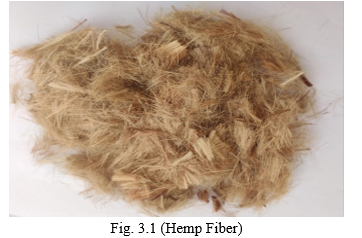
Physical properties of Hemp Fiber
Some physical properties of hemp fiber are as follows
- The colour of the hemp fiber is yellowish-grey to deep brown.
- The length of the hemp fiber is 4.5 to 7 feet.
- Due to high tensile strength hemp fiber is very strong fiber.
- Hemp fibers have poor plastic recovery.
- The stiffness of hemp fiber is high.
Chemical properties of Hemp Fiber
- Hemp fiber affect by dilute acids or concentrated acids.
- The organic solvent does not affect hemp fiber.
- Resistance to alkalis has excellent of hemp fiber.
B. Coconut Fiber: Coir fiber is a natural type fiber which is easily available in the rural area. When the outer shell of the coconut is extracted than the coir fiber or coconut fiber is produced. The coconut fiber is two types first one is brown fiber and the second one is white fiber. The brown fiber is prepared by the extracted of matured fiber on the other hand white fiber found by immature coconut [3], [7].
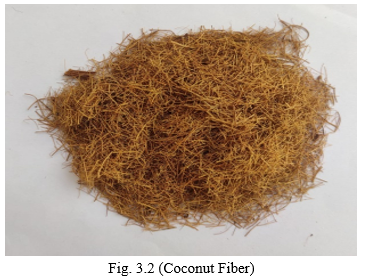
Physical properties of Coconut or Coir Fiber
- The length of the coconut fiber is 6 to 8 inches.
- The density of the coconut fiber is 1.41 gram/cc3.
- The elongation of the breaking of coir fiber is 30%.
- The diameter of the coir fiber is 0.1 to 1.5.
- The rigidity of the modulus of coir fiber is 1.8924 dyne/cm2.
- Coir fiber is highly flammable.
Uses of Coconut Fiber
- For making the rope white coir fibers are mostly used.
- For making carpets brown fibers are used.
- For the formation of door mates, brown fibers are used.
- In the automobile industry, coir fiber is used for making sheets.
- Coir fiber composite is also used for home decorations piece.
- Coir fiber is also used for making sofas.
- Coconut fiber is also used for making brushes.
- For making particleboard coir fiber use.
C. Jute Fiber: Jute fiber is obtained from the outer skin of the jute plant. The jute fiber is extracted from the outer skin of the jute plant. It's a natural fiber due to golden and silky sine colour it is also known as golden fiber. Jute fibers are extracted by either biological process or chemical process. Jute fiber is 100% biodegradable so it is also eco-friendly [10].
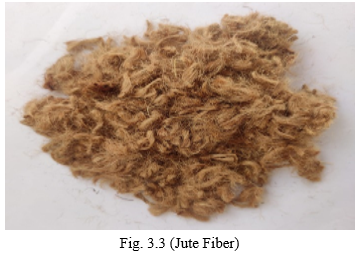
Advantages of Jute Fiber
- The antistatic properties are great.
- The thermal conductivity is low.
- The properties of moisture regain are good.
- Jute fiber is 100% biodegradable.
- The cost of jute fiber in the market is very cheap.
Physical properties of Jute Fiber
- The effect of heat and light are average.
- The effect of micro-organisms is much batter then cotton.
- The abrasion resistance of jute fiber is a minimum.
- The dimensional stability of jute fiber is excellent.
- The fiber length of the jute fiber is 6 to 11 feet.
- The ultimate length of the jute fiber is 1.5 to 4 mm.
Chemical properties of Jute Fiber
- Jute fiber is easily damaged by dilute acids.
- When jute fiber is heated with caustic soda it loses its actual weight.
- In the presence of direct sunlight, it loses their colour.
Uses of Jute Fiber
- Jute fiber is used for the production of cloths for wrapping blades and to the production of coarse cloths.
- It is also used for making camp beds.
- The most common use of this fiber is making rope.
2. Matrix Material
Matrix materials are those materials which bind the fiber reinforcement and provide a composite better surface quality and also provide the actual shape of the composite. There are three types of a matrix such as a polymer, metals ceramics. The main tasks of the matrix materials for composites production are to hold and protect the fiber [4].
Matrixes materials take part for increment the physical and mechanical properties of composite material because they are a binding element. Matrix materials are used for binding the one fiber to another fiber component [3].
The matrix material used in this research for binding the natural fiber is phenol-formaldehyde.
a. Phenol Formaldehyde Resin: Phenol formaldehyde resins are synthetic resin which is obtained by the chemical reaction of phenol with formaldehyde. It is normally known as Bakelite. It is mostly used for coating [7].
b. Properties of Phenol Formaldehyde
- Phenol formaldehyde has excellent resistance to heat.
- Phenolic resins are not conductive and flame resistant.
- The thermal insulation of phenol-formaldehyde resins is excellent.
- The density is low.
- The durability of the phenol-formaldehyde resin is excellent.
- Phenolic resigns can easily mould in the desired shape.
- At normal atmospheric conditions, stability and dimensional accuracy are excellent.
- Phenolic resins are easily molded in different shapes at accurate dimensions.
- At normal atmospheric conditions, the dimensional accuracy and stability are good.
- Due to high creep resistance, the dimensional stability of phenolic resin is complemented.
- Phenolic resins have maximum resistance to deformation under the load.
- Phenolic resins are suitable for less voltage electrical insulation.
- Heat and electrical resistance of phenolic resin are good.
- Phenolic resin composite absorbed less water so they have low water absorption property.
- Phenolic resin composite can be easily used outside for a short time of period.
B. Composite Fabrication
During this research natural fiber is taken for sample preparation. The fibers which are taken for sample preparation are jute fiber, hemp fiber, and coconut fiber.
The natural fibers are known as reinforced material. In this study, phenol-formaldehyde uses as an adhesive material.
For the fabrication of composite samples, the dimensions of the mould are the length is 200mm, width is 200mm and the thickness of the sample is 5mm.
These dimensions are actual dimensions of a real composite specimen.
For the fabrication of any composite material, there are some facture present which is as follows
- Fiber length.
- Fiber volume ratio or fiber volume fraction.
- The orientation of fiber.
- The thickness of the composite.
So due to some analysis of previous research work of some researchers, some results came out. By analysing the result the final composite preparation parameter came out which are as follows:
- In this research, the fiber is randomly oriented.
- In this research work, the fiber length is fixed that is 12mm.
- The thickness of the composite is fixed that is 5mm.
- In this study, the fiber ratio is not fixed. Four samples prepare with different fiber ratios.
The composition and the designation for composite fabrication for this study are listed in Table 3.2.
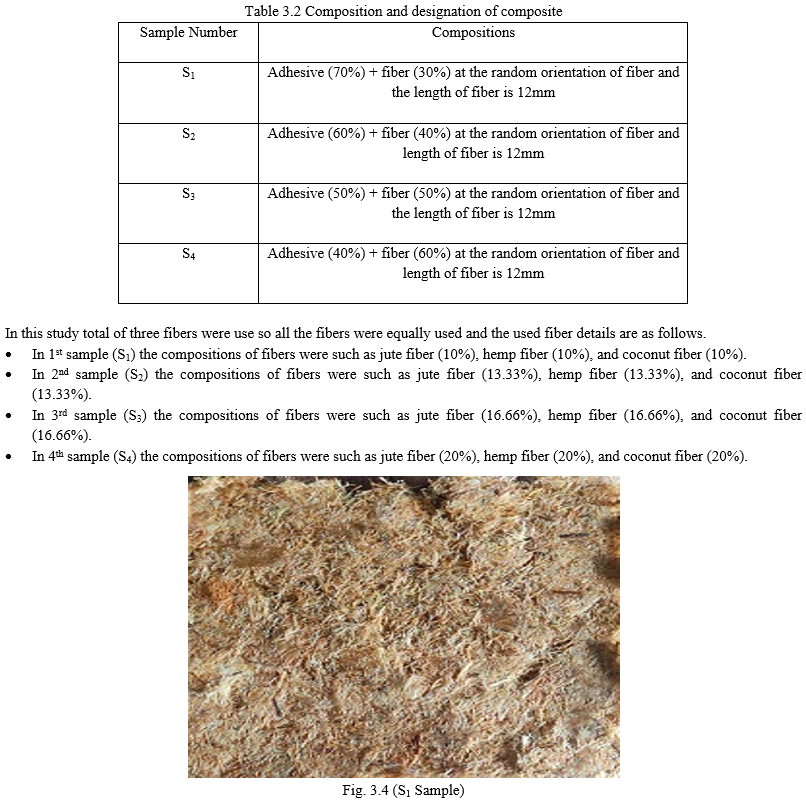
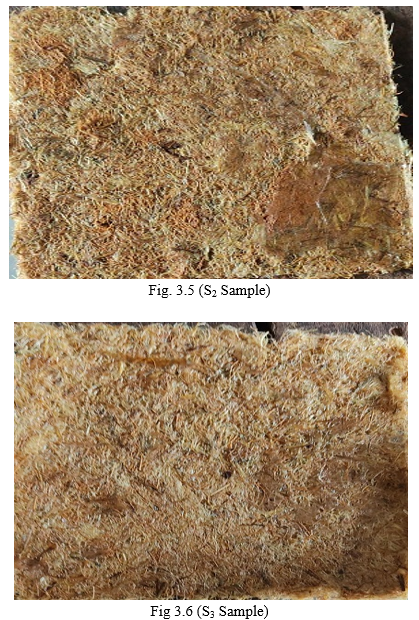
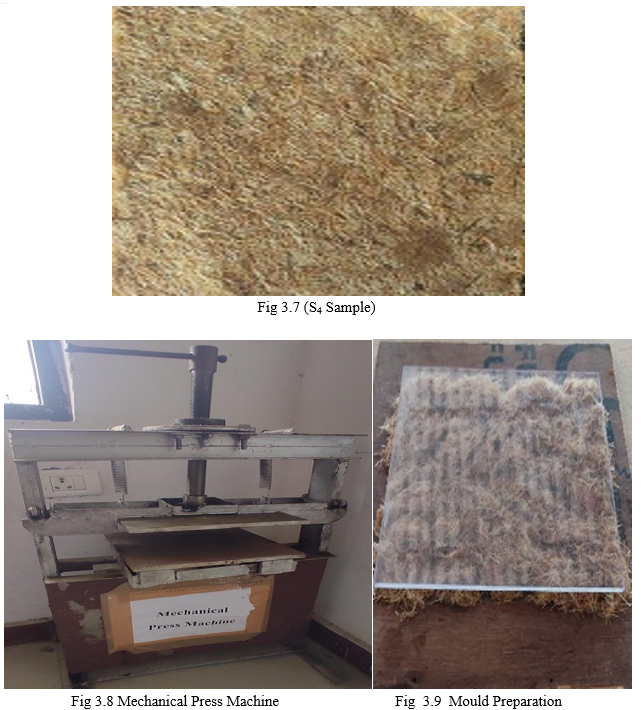
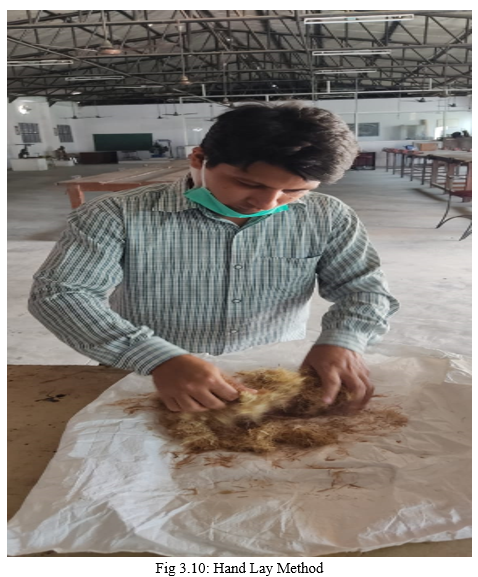
IV. RESULT AND DICUSSION
This chapter represents the variation of the physical and mechanical properties of composites. The physical and mechanical properties which are tested during the research work are as follows.
A. Tests For The Result Analysis Of The Research Work
Two types of tests are performed during this research which is as follows
- Tests for Physical Properties Analysis
Physical properties test which is tested during this research work are as follows
a. Density of composite
b. Moisture content present in the work piece
c. Water absorption test for 2 hours and 24 hour
d. Liner expansions in length and width for 2 hour soaking
e. The thickness of swelling at 2 hour soaking
2. Tests for Mechanical Properties Analysis
a. Modulus of Elasticity
b. Flexural strength
B. Inspections
- Density Inspection
The density of the composite played an important role in the performance of composites. The density of composite is affected by all the properties of the composite.
The density of any composite is determined by using all thickness of a composite. All the dimensions are measured with an accuracy of not less than 0.3%, and weight is measured with an accuracy of not less than 0.2%.
The density calculated as follows

Where
m = oven dry weight (gm)
l = length of sample (cm)
w = width of sample (cm)
t = thickness of sample (cm)
For the density calculation, the dimensions of the samples are the same which are such as the thickness of samples is 0.5cm, the width of the samples is 7.5cm and the length of the samples is 15cm.In this research, the density of the samples is approximately the same.
Fiber and adhesive ratios in samples are as follows

Observation Table for Density Analysis
For the density analysis total of three tests were performed for each sample and average density of the samples as shown in the observation table.

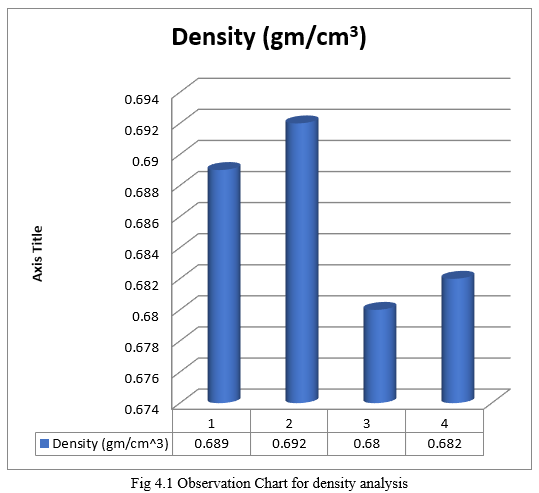
2. Moisture Content Test: The average moisture present in particleboards should not be less than 2% nor more than 10% based on the oven-dry weight. The standard dimensions for this test are 15cm length and 7.5cm width with the full thickness of specimens. In this test the thickness is 0.5cm.
The moisture content calculated as

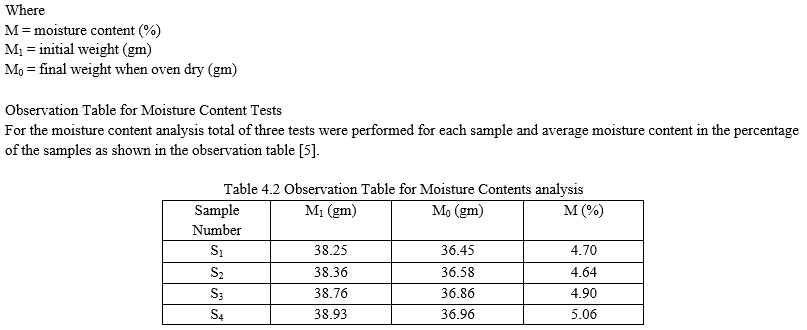
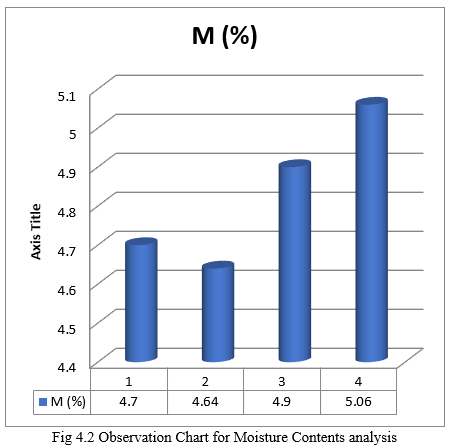
3. Water Absorption Test: The water absorption test defined the water absorption behaviour of the composite [9][5]. By this test, we can calculate the effect of absorbed water on dimensions of the composite. For performing this test the specimen dimensions are 15cm length and 15cm width with the full thickness of samples. The thickness of the sample is 0.5cm. Each test sample was immersed in freshwater for 2 and 24 hours. The temperature of the water should be present between 25 degrees Celsius to 29 degrees Celsius.
The total water absorbed by test samples calculated as
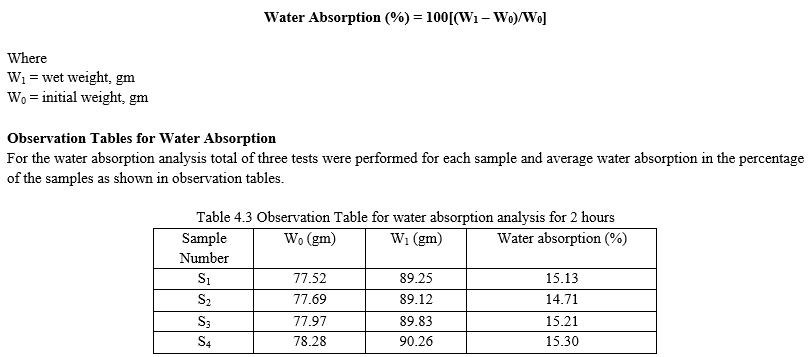
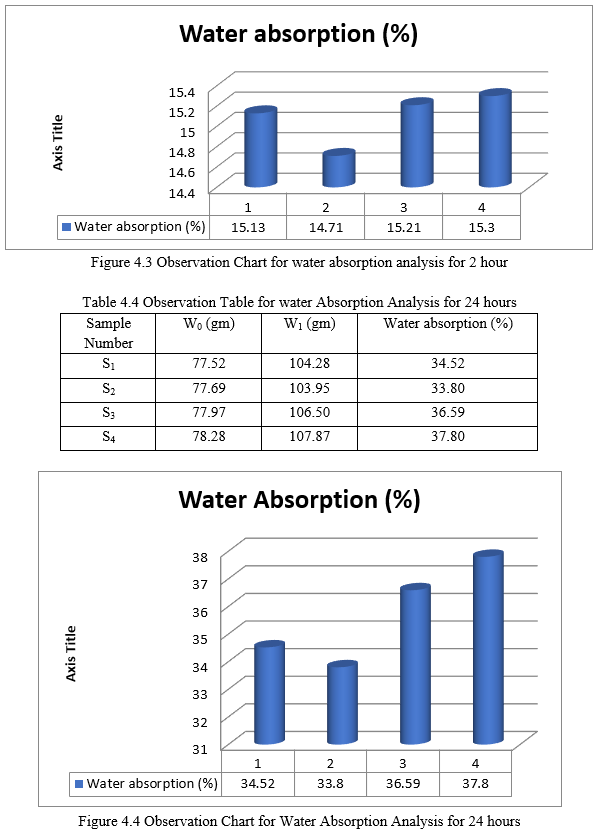
4. Linear Expansion (swelling in water) Test: The linear expansion test provides the change of the dimensions (length and width) during the swelling in water. For performing this test the dimension of the specimen is 7.5cm wide and 15cm length with the full thickness of the specimens. The thickness of the specimen is 0.5cm. This test was performed for 2 hours of water soaking.
a. Length Expansion
Linear expansion in length calculated as
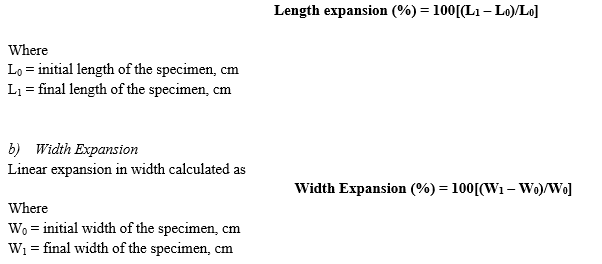
Observation Tables for Linear Expansion
For the linear expansion analysis total of three tests were performed for each sample and average linear expansion of length and width in the percentage of the samples as shown in observation tables.
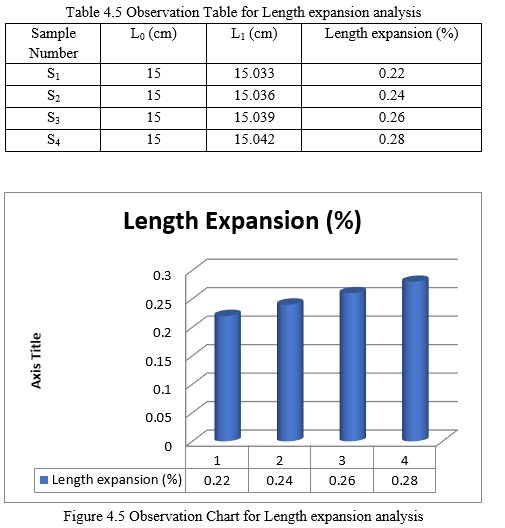
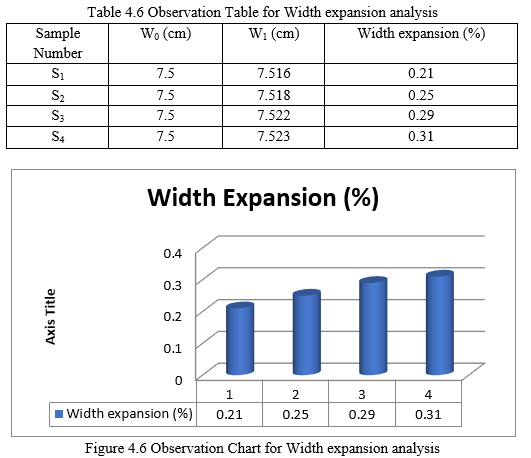
5. Thickness Expansion (swelling in water) Test: The thickness expansion test provides the change of the thickness during the swelling in water. For performing this test the dimension of the specimen is 7.5cm width and 15cm length with the full thickness of the specimens. The thickness of the specimen is 0.5cm. This test was performed for 2 hours of water soaking.
Thickness expansion is calculated as

Where
T0 = initial length of the specimen, cm
T1 = final length of the specimen, cm
Observation tables for thickness expansion
In thickness expansion analysis total of three tests performed for each specimen and average expansion in thickness in the percentage of the samples as shown in observation tables.
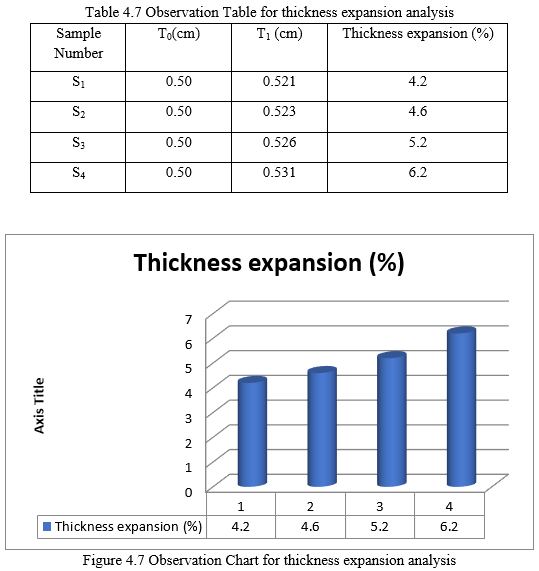
6. Modulus of Elasticity: Modulus of elasticity of any composite is a material property that explains all about the stiffness of the composite. For performing this test the dimension of the specimen is 50mm width and the length of the specimen is 24 times of thickness with the full thickness of the specimens. The thickness of the specimen is 5mm.
The MOE of any composite specimen is calculated as
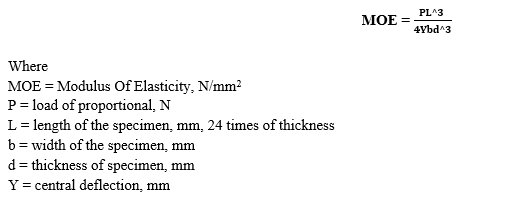
Observation Tables for Modulus of Elasticity
For modulus of elasticity analysis total of three tests performed for each sample and all the dimensions and final results of the analysis are shown in the observation table.
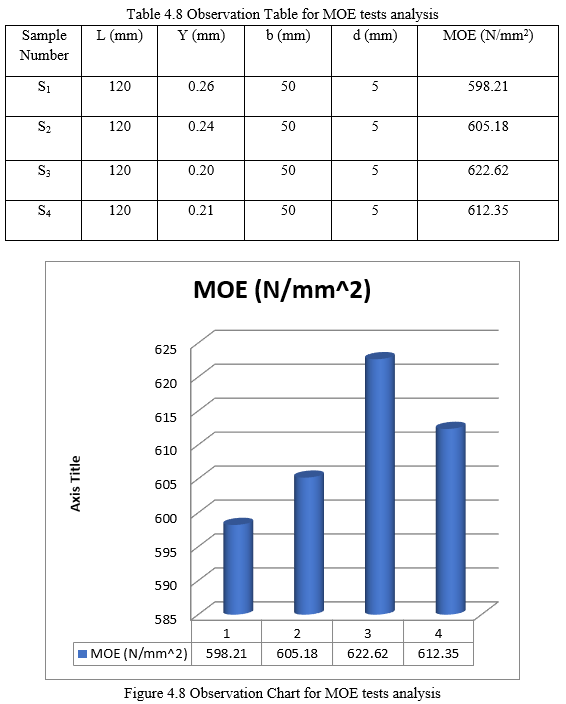
7. Modulus of Rupture: Modulus of rupture has become an important measurement of the composite board for calculating the bending strength. It is used for comparing one material to another material. For performing this test the dimensions are such as length of the specimen is 24 times of thickness and width of the specimen is 50mm with the full thickness of the specimen. The thickness of the composite is 5mm.
The modulus of rupture of any composite specimen is calculated as
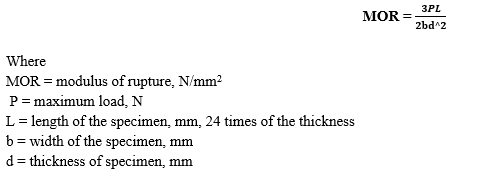
Observation Tables for Modulus of Rupture
For the modulus of rupture analysis total of three tests performed for each sample and all the dimensions and final results of the analysis are shown in the observation table.
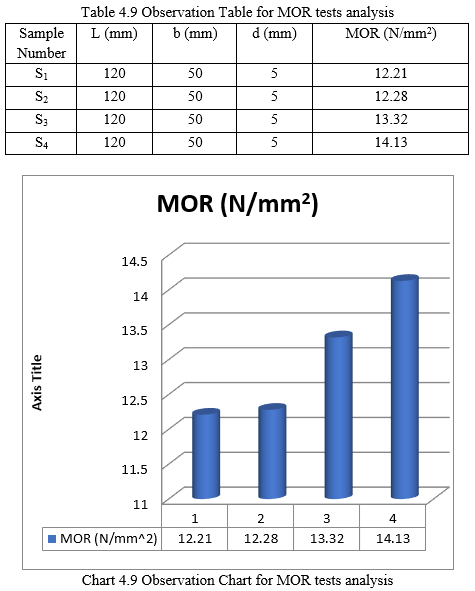
Conclusion
A. Conclusion The fabrication of composite material by using natural fiber as reinforced material and phenol-formaldehyde as the adhesive has been completed. In this research the total number of 4 samples was fabricated and the names of the samples were S1, S2, S3, and S4. The S1, S2, S3, and S4 samples contain fiber ratios 30%, 40%, 50%, and 60% respectively and fiber length is fixed that was 12mm. After investigating all the testing results of all the samples of composites material the following conclusions obtained from these investigations are as follows: 1) The fabrications of the composites was completed by using phenol-formaldehyde as adhesive and natural fiber as reinforced material. 2) At a 40% fiber volume ratio the density of composite was found maximum in comparison to other fiber volume ratio samples. 3) At 40% fiber volume ratio the moisture present in the composite was found minimum and at 60% fiber volume ratio the moisture present in the composite was found maximum. 4) The composite of 40% fiber volume ratio absorbed minimum water during the water absorption test which was performed for 2 hour soaking and the composite of 60% fiber volume ratio absorbed maximum water during the water absorption test for 2 hour soaking. 5) The composite of 40% fiber volume ratio was absorbed minimum water during water absorption test which was performed for 24 hour soaking and the composite of 60% fiber volume ratio was absorbed maximum during the water absorption which was performed for 24 hour soaking. 6) The expansion in length and width were found minimum for 30% fiber volume ratio composite and were found a maximum for 60% fiber volume ratio composite during the linear expansion test. 7) The expansion in thickness was found minimum for 30% fiber volume ratio composite and was found maximum for 60% fiber volume ratio composite during the thickness expansion (swelling in water) test. 8) During the modulus of elasticity test, the modulus of elasticity was found maximum for 50% fiber volume ratio composite and was found minimum for 40% of fiber volume ratio composite. 9) During the modulus of the rupture test, the modulus of rupture was found maximum for 60% fiber volume ratio composite and was found minimum for 30% fiber volume ratio composite. B. Scope For Future Work After the analysis of this research some conclusions came out which is satisfactory but there is board scope for future researcher to investigate the current research. So we can say that this research work can be further expanded to research other feature of the composite which is as follows 1) Replace the fiber or use of other natural fiber. 2) New future work is that we can replace phenol-formaldehyde resin to urea-formaldehyde resin. 3) We can fix the fiber volume ratio and varying fiber length. 4) We can also change the orientation of fiber. 5) We can replace one natural fiber to synthetic fiber.
References
[1] http://composite.about.com/od/aboutcompositesplastics/a/History of Composites.htm (Date of access 1 June 2015). [2] https://www.thoughtco.com/history-of-composites-820404 Date of access August 01, 2018 [3] W. D. Callister, “Materials Science and Engineering: An Introduction” 7th Edition, ISBN-13: 978-0-471-73696-7. [4] http://nptel.ac.in/courses/101104010/1 (Date of access 3 June 2015). [5] R. H. Hu, M. Sun, J. K. Lim, “Moisture absorption, tensile strength and microstructure evolution of short jute fibre/polylactide composite in hygrothermal environment”Materials and Design, 31 (2010) 3167–3173. [6] A. S. Singha, R. K. Rana, “Natural fibre reinforced polystyrene composites: Effect of fibre loading, fibre dimensions and surface modification on mechanical properties” Materials and Design, 41 (2012) 289–297. [7] M. P. Groover “Fundamentals of Modern Manufacturing: Materials, Processes and Systems” ISBN: 9780470467002. [8] K. M. M. Rao, K. M. Rao, A.V. Ratna Prasad “Fabrication and testing of natural fibre composites: Vakka, sisal, bamboo and banana” Materials and Design, 31 (2010) 508–513. [9] P. A.Shreekumar,Selvin P Thomas, Jean marc Saiter, Kuruvilla Josseph,. Effect of fibre surface modification on the mechanical and water absorption characteristics of sisal/polyester composites fabricated by resin transfer moulding” Composites:Part A, 40 (2009) 1777–1784 [10] D. Chandramohan, K. Marimuthu “A review on natural fibres” IJRRAS 8 (2) August 2011. [11] C. Capela, S. E. Oliveira, J. Pestana, J.A.M Ferreira, Effect of fiber length on the mechanical properties of high dosage carbon-reinforced Volume 5, 2017, Pages 539-546 [12] Himanshu Bisaria, M. K. Gupta, P. Shandilya, R. K. Srivastava,.Effect of fiber length on mechanical properties of randomly oriented short jute fiber reinforced epoxy composite\" Volume 2, Issues 4–5, 2015, Pages 1193-1199 [13] By Hari Om Maurya, M. K. Gupta, R. K. Srivastava, H. Singh, Study on the mechanical properties of the epoxy composite using short sisal fiber Volume 2, Issues 4–5, 2015, Pages 1347-1355\". [14] Wim Nhuapeng, Wandee Thamjaree Fabrication of mechanical properties of hybrid composites between pineapple fiber/Styrofoam particle /paper tissue Volume 17, Part 4, 2019, Pages 1444-1450. [15] Prakash Marimuthu k, Mohan Kumar S, Ravi Kumar V, Govindaraju H. K. Characterization of mechanical properties of epoxy reinforced with glass fiber and coconut fiber Volume 16, Part 2, 2019, Pages 661-667” [16] J.A. Flores, J.J. Pastor, A. Martinez-Gabarron, F.J. Gimeno Blanes, M.J. Frutos Pressure Impact on Common Reed Particleboards Manufacturing Procedure” By Volume 1, 2011, Pages 499-507. [17] Ashish kumre, R S Rana, and Rajesh Purohit A Review on mechanical property of sisal glass fiber reinforced polymer composites” Volume 4, Issue 2, Part A, 2017, Pages 3466-3476. [18] Sunil Singh Rana, M. K. Gupta, R. K. Srivastava “Effect of variation in frequencies on dynamic mechanical properties of short sisal fiber reinforced epoxy composite Volume 4, Issue 2, Part A, 2017, Pages 3387-3396\". [19] F. Rezaei, R. Yunus, N.A. Ibrahim. “Effect of fiber length on thermo-mechanical properties of short carbon fiber reinforced polypropylene compositesVolume 30, Issue 2, February 2009, Pages 260-263” [20] Tiesong Lin, Dechang Jia, Peigang He, Meirong Wang, Defus Liang\"Effects of fiber length on mechanical properties and fracture behaviour of short carbon fiber reinforced geopolymer matrix composites Volume 497, Issues 1–2, 15 December 2008, Pages 181-185”
Copyright
Copyright © 2022 Sudarshan Kandpal, Ashutosh Mishra, Dr. Akhilesh Kumar Chauhan, Mr. Sanjay Tiwari. This is an open access article distributed under the Creative Commons Attribution License, which permits unrestricted use, distribution, and reproduction in any medium, provided the original work is properly cited.

Download Paper
Paper Id : IJRASET40017
Publish Date : 2022-01-20
ISSN : 2321-9653
Publisher Name : IJRASET
DOI Link : Click Here
 Submit Paper Online
Submit Paper Online

